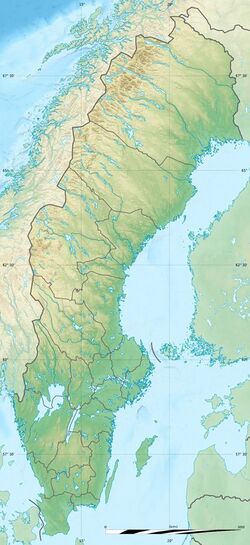Earth:Köpinge Sandstone
| Köpinge Sandstone Stratigraphic range: Latest early-middle late Campanian ~80–75 Ma | |
|---|---|
| Type | Formation |
| Lithology | |
| Primary | Highly calcareous and glauconitic sandstone |
| Location | |
| Coordinates | [ ⚑ ] : 55°30′N 13°54′E / 55.5°N 13.9°E |
| Paleocoordinates | [ ⚑ ] 45°42′N 14°18′W / 45.7°N 14.3°W |
| Region | Skåne |
| Country | |
| Extent | Localized outcrops in the Vomb Trough |
| Type section | |
| Named for | Köpingebro |
The Köpinge Sandstone is a highly calcareous and glauconitic sandstone geologic formation of the Vomb Trough in Skåne, southernmost Sweden. The formation dates to the latest early to middle late Campanian stage of the Late Cretaceous and has provided fossils of ammonites, belemnites, the shark Cretalamna borealis and the mosasaurid Hainosaurus. Ex situ occurrences in Pleistocene deposits have provided a dorsal vertebra of a possible elasmosaurid.
Description
The Köpinge Sandstone has been recorded from a number of small outcrops, the majority of which are not accessible today, northeast of the town of Ystad, around Köpingemolla, Svenstorp, Valleberga, Ingelstorp, Herrestad and Fredriksberg.[1]
The formation comprises yellow highly calcareous and glauconitic sandstones and ranges in age (on the basis of abundant belemnites and ammonites) from the latest early Campanian to the middle late Campanian.[2]
Christensen (1986) recorded two belemnite assemblages from the area, i.e., an older one comprising Belemnellocamax mammillatus and Belemnitella mucronata , and a younger one with B. mucronata and Belemnitella aff. langei. Ammonites (Gaudryceras sp., Pachydiscus haldemsis, Patagiosites stobaei, Nostoceras junior, Lewyites elegans, Baculites cf. aquilaensis, B. angustus, B. schlueteri, Trachyscaphites spiniger spiniger and Hoploscaphites ikorfatensis)[1] from the Köpinge district indicate an early late Campanian age.[3] The formation has also provided fossils of the mosasaurid Hainosaurus.[4][5]
An isolated dorsal vertebra of a possible elasmosaurid was found in a Pleistocene Geschiebe, an ex situ occurrence of the Campanian formation, in southern Sweden.[6]
The shark Cretalamna borealis recovered from the formation was described in 2015.[7]
See also
- List of fossiliferous stratigraphic units in Sweden
- Kristianstad Basin
- Folkeslunda Limestone, Ordovician fossiliferous formation of Sweden with ex situ fossil assemblages
References
- ↑ 1.0 1.1 Kennedy & Christensen, 1997, p.81
- ↑ Siversson et al., 2015, p.356
- ↑ Köpinge at Fossilworks.org
- ↑ Lindgren, 2005
- ↑ Köpinge Sandstone at Fossilworks.org
- ↑ Foth et al., 2010, p.36
- ↑ Siversson et al., 2015, p.353
Bibliography
- Siversson, Mikael; Johan Lindgren; Michael G. Newbrey; Peter Cederström, and Todd D. Cook. 2015. Cenomanian–Campanian (Late Cretaceous) mid-palaeolatitude sharks of Cretalamna appendiculata type. Acta Palaeontologica Polonica 60. 339–384. Accessed 2020-07-09.
- Foth, Christian; Johannes Kalbe, and René Kautz. 2010. First evidence of an Elasmosauridae (Reptilia: Sauropterygia) in a Geschiebe from the Campanian (Upper Cretaceous) of South Scandinavia. Zitteliana 29. 36. Accessed 2020-07-09.
- Lindgren, J. 2005. The first record of Hainosaurus (Reptilia: Mosasauridae) from Sweden. Journal of Paleontology 79. 1157-1165.
- Kennedy, William James, and Walter Kegel Christensen. 1997. Santonian to Maastrichtian ammonites from Scania, southern Sweden. Fossils and Strata 44. 75–128. Accessed 2020-07-09.
 |


